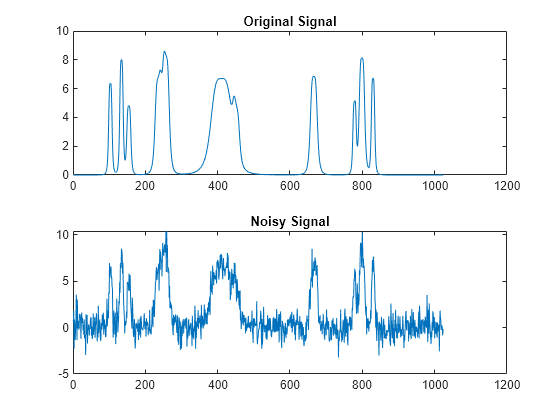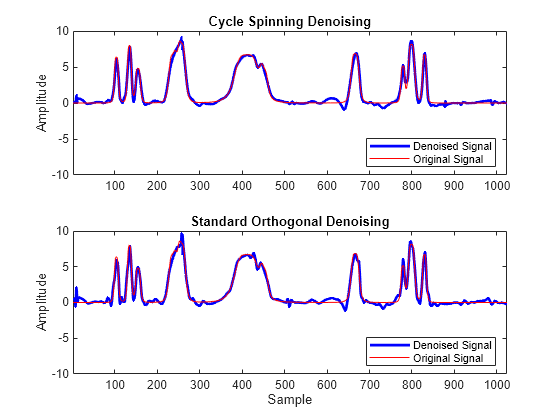Translation Invariant Wavelet Denoising with Cycle Spinning
Cycle spinning compensates for the lack of shift invariance in the critically-sampled wavelet transform by averaging over denoised cyclically-shifted versions of the signal or image. The appropriate inverse circulant shift operator is applied to the denoised signal/image and the results are averaged together to obtain the final denoised signal/image.
There are N unique cyclically-shifted versions of a signal of length, N. For an M-by-N image, there are MN versions. This makes using all possible shifted versions computationally prohibitive. However, in practice, good results can be obtained by using a small subset of the possible circular shifts.
The following example shows how you use wdenoise
and circshift to denoise a 1-D signal using
cycle spinning. For denoising grayscale and RGB images, wdenoise2 supports cycle spinning.
1-D Cycle Spinning
This example shows how to denoise a 1-D signal using cycle spinning and the shift-variant orthogonal nonredundant wavelet transform. The example compares the results of the two denoising methods.
Create a noisy 1-D bumps signal with a signal-to-noise ratio of 6. The signal-to-noise ratio is defined as where is the length of the signal, is the squared L2 norm, and is the variance of the noise.
rng default [X,XN] = wnoise('bumps',10,sqrt(6)); subplot(2,1,1) plot(X) title('Original Signal') subplot(2,1,2) plot(XN) title('Noisy Signal')

Denoise the signal using cycle spinning with 15 shifts, 7 to the left and 7 to the right, including the zero-shifted signal. Use wdenoise with default settings. By default, wdenoise uses Daubechies' least-asymmetric wavelet with four vanishing moments, sym4. Denoising is down to the minimum of floor(log2(N)) and wmaxlev(N,'sym4') where N is the number of samples in the data.
ydenoise = zeros(length(XN),15); for nn = -7:7 yshift = circshift(XN,[0 nn]); [yd,cyd] = wdenoise(yshift); ydenoise(:,nn+8) = circshift(yd,[0, -nn]); end ydenoise = mean(ydenoise,2);
Denoise the signal using wdenoise. Compare with the cycle spinning results.
xd = wdenoise(XN); subplot(2,1,1) plot(ydenoise,'b','linewidth',2) hold on plot(X,'r') axis([1 1024 -10 10]) legend('Denoised Signal','Original Signal','Location','SouthEast') ylabel('Amplitude') title('Cycle Spinning Denoising') hold off subplot(2,1,2) plot(xd,'b','linewidth',2) hold on plot(X,'r') axis([1 1024 -10 10]) legend('Denoised Signal','Original Signal','Location','SouthEast') xlabel('Sample') ylabel('Amplitude') title('Standard Orthogonal Denoising') hold off

absDiffDWT = norm(X-xd,2)
absDiffDWT = 12.4248
absDiffCycleSpin = norm(X-ydenoise',2)
absDiffCycleSpin = 10.6124
Cycle spinning with only 15 shifts has reduced the approximation error.